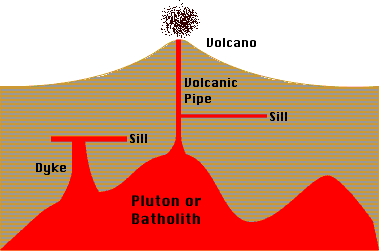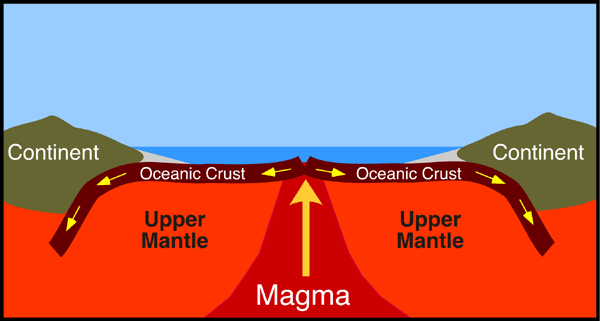Studies of seismic waves have discovered that the Earth's crust consists of two basic types. Beneath the oceans we find a crust that is on average 7 kilometers thick and composed mainly of basalt. Oceanic crust also has a density of about 3.0 grams per cubic centimeter. The continent's are composed of mainly granitic rock whose thickness varies between 10 and 70 kilometers. The thickest portions of continental crust are found under the various mountain ranges. Continental crust is also lighter than oceanic crust having a density of about 2.7 grams per cubic centimeter. Oceanic and continental rocks also differ from each other in terms of age. Continental crust contains some very old rocks that were formed during the Precambrian between 3 and 4 billion years ago. Oceanic rocks are normally quite young deposits. Isotopic dating of the rocks found on the sea-floor indicates that they were created less that 180 million years ago (see topic 10i and Figure 10i-1 for more information on the age of oceanic crust).
Variations in the age, density, and chemical composition of oceanic and continental crust suggest that these lithospheric deposits were created by different processes. The following discussion describes these differences.
Continental Crust
All of the Earth's continents have a core foundation that is made of mixtures of very old granite, gneiss, schist, sedimentary, and volcanic rocks. This core foundation is often referred to as a shield or basement rock. Rocks found in the shields were formed during the Precambrian and are some of the oldest rocks found on the Earth. In Canada, some of the metamorphic rocks have been dated to an age of 3.96 billion years. Geologists believe that the major continental cores were formed by the early solidification of the lighter components of magma between 3.9 and 3.8 billion years ago. The continental shields are generally covered by younger sedimentary deposits. These sedimentary rocks constitute the interior platforms of the continents. The oldest platform rocks were laid down in shallow seas about 600 million years ago. In central North America, the platform sedimentary deposits are between 1000 to 2000 meters thick. Together the shield and platform form what geologists call a craton. Most of the Earth's continental cratons have been tectonically stable and have experienced little deformation for hundreds of millions of years.
Around the edge of the continental cratons are the continental margins. The continental margins are primarily composed of sedimentary rocks. These sedimentary rocks were originally laid down in the oceans. Tectonic collisions and plate subduction caused the accretion of these deposits at the edges of the continental cratons (Figure 10j-1). In some cases, this accretion is modified by the processes of tectonic compression, folding, and faulting to produce mountain ranges.
Figure 10j-1: The following animation shows the accretion of sedimentary material from the ocean floor onto the continental margin. The movement of oceanic crust under the continents is the mechanism responsible for transporting the sedimentary materials found on the ocean floor to the edge of the continents. The animation also describes how friction between the oceanic and continental plates creates hot plumes of magma which migrate up through the continental mass to form plutonic and extrusive igneous features (like volcanoes). (To view this animation your browser must have Apple's QuickTime plug-in. The QuickTime plug-in is available for Macintosh and Windows operating system computers and can be downloaded FREE from the World Wide Web site www.apple.com/quicktime). |
Igneous Activity and the Continents
Materials are also added to continental crust through intrusive and extrusive igneous activity. Plumes of magma from the Earth's asthenosphere are generated from the friction produced at the contact zone where oceanic crust slides past continental crust (Figure 10j-1). These plumes then rise upward into continental crust to form granitic plutons or a variety of volcanic features on the Earth's surface. A pluton can be defined as any igneous intrusion of rock that forms a kilometer or more below the Earth's surface. The diagram (Figure 10j-2) below illustrates some of the features associated with igneous intrusions or plutons. Some of the major features include:
Dyke: thin vertical veins of igneous rock that form in the fractures found within the crust. Because these intrusive features cool quickly their rocks are dominated with fine mineral grains.
Sill: horizontal planes of solidified magma that run parallel to the grain of the original rock deposit.
Batholith: large plutonic masses of intrusive rock with more than 100 square kilometers of surface area.
Volcanic Pipe: if a dyke reaches the surface of the Earth it is then called a volcanic pipe. Igneous deposits produced by this feature are extrusive in nature.

Figure 10j-2: Common plutonic features.
Plumes that are able to reach the Earth's surface produce volcanoes. Most of the continental volcanoes found on our planet are located along the edge of the continents where oceanic crust is being actively subducted. In North America, the zone of active volcanoes is located on the west coast where the subduction of the Pacific plate occurs. Volcanoes add mass to the continents when magma produces lava flows, tephra, and volcanic ash.
Oceanic Crust
Unlike continental crust, oceanic crust is actively being created at the various mid-oceanic ridges. At the mid-ocean ridges, magma erupts onto the ocean floor in centrally located rift zones (Figure 10j-3). The newly added rock then horizontally pushes previously created ocean crust away from the rift in a conveyor belt fashion. Because of this process, we find that the age of oceanic crust increases as we move away from the rift zone (see Figure 10i-1). When the oceanic crust encounters a slab of continental crust it becomes subducted because of its greater density. This process causes the oceanic crust to return to the mantle were it is re-melted into magma. The process also causes the movement of continental crust across the surface of the Earth.

| Figure 10j-3: Formation of oceanic crust at rift zones located in the mid-oceanic ridges. Beneath the rift zone upwellings of magma occur in the mantle. These upwellings produce fissures and volcanoes on the ocean floor surface. The added rock, produced from the solidification of magma, pushes previously formed oceanic crust horizontally away from the rift zone like a conveyor belt. Ocean crust is returned to the mantle through subduction. This can occur when ocean crust meets continental crust or other ocean plates. |